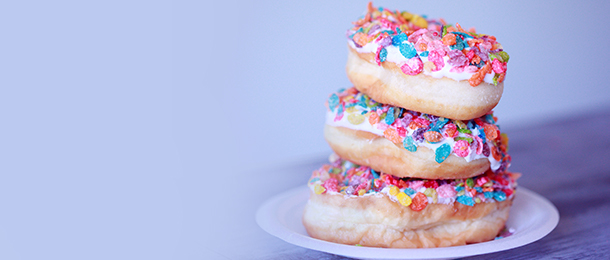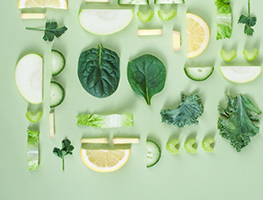Do you remember when fat was given a bad rap? When we were led to believe that getting rid of all fat from our diet was the best for us? Now it turns out that we need almost all kinds of fat, yes, even saturated fat for good health (albeit in small amounts). Well, you have to ask, is sugar the next baddie to steer clear of? Well, let’s takes a look at the nutritional facts on sugar.
What’s a carb and what’s a sugar?
Quite simply, sugars are a type of carbohydrate (let’s stick with carbs, so much faster). Carbs in our food are made up from combinations of different types of sugar, like glucose, fructose or galactose. Look at your breakfast - the sugar in that delicious piece of fruit you had for morning tea contains fructose, the sugar in the milk in your latte, lactose (made up of two sugars, glucose and galactose), and the teaspoon of sugar you added to your cuppa is made up of glucose and fructose.
In the past, there has been a tendency to see all simple sugars as bad, and some people have confused them with refined sugars (refined table sugar or other sugars produced commercially and used to add sweetness to food). Many people are often confused about sugars and carbohydrates and label carbs as bad for you, but clearly this is wrong. It’s important to remember that the sugars that naturally occur in our foods are in fact all useful to the body. Given that sugars occur naturally in plenty of our food and are vital to good health, it’s a little scary to hear or read of someone suggesting sugar shouldn’t pass your lips.
Carbohydrate
There are three main forms of carbohydrates:
Sugar. Sugar is the simplest form of carbohydrates. Sugar occurs naturally in some foods, including fruits, vegetables, milk and milk products. Sugars include fruit sugar (fructose), table sugar (sucrose) and milk sugar (lactose).
Starch. Starch is a complex carbohydrate, meaning it is made of many sugar units bonded together. Starch occurs naturally in vegetables, grains, and cooked dry beans and peas.
Fibre. Fibre also is a complex carbohydrate. Fibre occurs naturally in fruits, vegetables, whole grains, and cooked dry beans and peas.
Carbs are divided into two types: complex and simple carbohydrates.
Complex carbohydrates:
Are the body's main source of energy. During the digestion process, these carbs are converted in to energy to fuel your body.
Are made up of three or more sugars, strung together like a necklace or branched like a coil, this makes it take longer to break down during the digestive process. Often referred to as dietary starch.
Are filled with vitamins, minerals, fibre and other nutrients.
Generally have a lower glycemic load, which means that you will get lower amounts of sugars released at a more consistent rate – instead of peaks and valleys – to keep you going throughout the day
Are found in green vegetables; whole grains and foods made from them, such as oatmeal, pasta, and whole-grain breads; starchy vegetables such as potatoes, sweet potatoes, corn, and pumpkin; beans, lentils, peas; and fruit,
Simple carbohydrates, on the other hand, rarely contain the nutrients found in complex carbohydrates, and therefore they don't contribute to your overall health.
Simple carbohydrates are sugars. All simple carbohydrates are made of just one or two sugar molecules. They are the quickest source of energy, as they are very rapidly digested. Simple carbs are found in table sugar (white and brown), syrup, molasses, jams, fruit drinks, soft drinks and – of course – candy.
However, both complex and simple carbs are necessary to a healthy diet. Here are a few things to remember about carbs:
Not all carbs are the same;
You should never avoid them.
The higher in sugar and lower in fibre, the worse the carbohydrate is for you
Sugar is a type of carbohydrate.
The best forms of sugar are those found naturally occurring in foods, such as fruit, vegetables and dairy. Even some whole grains contain sugar. Sugar is actually a double sugar. Half is glucose, the body's most basic fuel. The other half is called fructose.
Added sugars found in many processed foods aren't good for you, particularly when consumed in great quantities. It is recommended that you limit your intake of these sugars to no more than 418 kilojoules a day for women and 627 kJ a day for men. Eating more than this amount can increase your risk of weight gain. Diets high in added sugar are also more likely to lack the proper nutrition needed to maintain good health.
Sugar-containing drinks, such as fruit drinks, sodas, energy drinks, sports drinks and sweetened bottled water, are the major source of added sugar in many people’s diets. The habitual sipping of sugary drinks has been linked to poor diet, weight gain, obesity and type-2 diabetes.
The most important simple carbohydrates to limit in your diet include:
Soda
Candy
Artificial syrups
Sugar
White rice, white bread and white pasta
Potatoes (which are technically a complex carb, but act more like simple carbs in the body)
Pastries and desserts
What does our body do to carbs and sugars?
When you eat carbohydrates, your pancreas secretes insulin, the hormone that enables you to digest starches and sugars. This release of insulin is sometimes called an insulin spike. The pancreas secretes insulin into the bloodstream, where it circulates and enables sugar to enter your cell. By doing this, insulin is lowering the amount of sugar in your bloodstream. As your blood sugar level drops, so too does the secretion of insulin from your pancreas.
When the insulin-producing cells in your body is under attack or destroyed due to an infection, your body will not be producing insulin. This causes the sugar to build up in your bloodstream instead of being transported into your cells and this can lead to type-1 diabetes.
Our digestive system breaks carbs down into their most simple form, i. e. sugar (also known as monosaccharides or single sugar). Sugars can easily be moved into the bloodstream and shifted to our cells to make energy. Sugar's link to body fat is via the release of insulin when sugar hits our bloodstream. Insulin opens cell “doors” to allow glucose to move in and be converted to energy. Insulin, however, is our fat storage hormone. So while we are consuming lots of sweet morsels our body is being told to store fat and hold onto it.
Complex carbohydrates, however, due to their resistance to our digestive processes end up at a different point and hence have different functions.
Where does all the sugar come from?
You might be surprised to know that only 25% of the added sugar we consume comes from what we ourselves add to our foods. 75% comes from the food we buy in the store, in our packaged food. For example:
One can of soft drink can have about 10 teaspoons of sugar
One Mars bar – up to 8.5 teaspoons
A tub of fruit yoghurt or a glass of cordial - up to 5 tsp
A sweet biscuit has up to 1 teaspoon of sugar
So, if you had a can of soft drink, a Mars bar and some fruit yoghurt over the day that would be a whopping 23. 5 teaspoons of sugar! This equates to 1180 kJ which roughly represents 14% of an average adults daily kilojoule requirements, and that's not even counting the rest of the meals that would be consumed over the day. Only 10-12% of the kilojoules we need over the day should come from sugars.
Let's be serious here, too much of anything isn't good for you! Too much calcium interferes with iron, too much vitamin C can cause unwanted reactions in the body, too much of one B vitamin can upset the balance of another and so on. We don't need to be told that we shouldn't wolf down loads of sugary foods, do we? But do we need to be aware of which sugars are more desirable and how to limit our exposure to sugars in the foods we purchase? After all, should we really be sweetening our food supply?
Spot me if you can!
Sugar can be hidden in many ways; in fact, there are a multitude of terms that are used to fool the unsuspecting consumer. Other ingredient names for sugar include:
Sucrose
Glucose
Lactose
Fructose
Sorbitol
Mannitol
Corn syrup
High-fructose corn syrup
Honey, molasses, golden syrup
Malt
Malt extract
Maltose
Rice extract
Invert sugar
Sound familiar? Have that list committed to memory? No, me neither, it's way too long, but you get the hang of picking sugar eventually.
Why cut down on sugar then?
Most adults and children eat more sugar than is recommended as part of a healthy balanced diet. You might even be doing it yourself. Either by adding it in deliberately (that third spoonful of sugar in your morning tea) or inadvertently, because you don't know how much sugar is in something. Many foods that contain added sugars (and often have few other nutrients) are also high in energy, which is measured in either kilojoules (kJ) or calories (kcal). Eating these foods often can contribute to you becoming overweight and being overweight can increase your risk of health conditions such as heart disease and diabetes.
Can I still eat carbs and sugar?
In spite of what everyone is saying to you about how bad carbs and sugars are for you – they remain an essential part of a healthy diet, and they also provide many important nutrients.
You can make them work for you as part of a balanced diet, by following these few simple rules:
Focus on fibre-rich fruit and vegetables. Aim for fresh, frozen and canned fruit and vegetables without added sugar. Fruit and vegetables add fibre, water and bulk, which help you feel fuller with less kilojoules added to your diet. Avoid fruit juices and dried fruit, they contain concentrated sources of natural sugar and therefore have more kilojoules.
Choose whole grains. Whole grains are better sources of fibre and other important nutrients, such as selenium, potassium and magnesium, than refined grains, which had to go through processes stripping them of their more nutritious parts and fibre.
Stick to low-fat dairy products. Milk, cheese, yogurt and other dairy products are good sources of calcium and protein, plus many other vitamins and minerals. Choose the low-fat versions, though, to help limit your kilojoule intake and saturated fat. Beware of dairy products that have added sugar. Read the labels!
Eat more beans and legumes. Legumes, which include beans, peas and lentils, are among the most versatile and nutritious foods available. Legumes are typically low in fat; contain no cholesterol; and are high in folate, potassium, iron, magnesium, beneficial fats, as well as soluble and insoluble fibre. Because they're a good source of protein, legumes can be a healthy substitute for meat, which contains more saturated fat and cholesterol.
Limit added sugars. Added sugar probably isn't harmful in small amounts. But there's no health advantage to consuming any amount of added sugar. In fact, too much added sugar, and in some cases naturally occurring sugar, can lead to such health problems as tooth decay, poor nutrition and weight gain. It can also increase your chances of heart disease and diabetes.
Use the nutrition panels not the marketing claims
Packaging has so many ticks, crosses, stamps and claims that it can hide the real value of a product. Make nutrition panels your friend in the fight for healthy eating. Specifically, let's look at the “carbohydrates” figure in comparison to the “total sugars” figure.
The total carbohydrates figure represents all sugars, naturally occurring and added, simple and complex.
The total “sugars” figure on the other hand indicates how much of these carbohydrates are simple sugars (naturally occurring and added).
While this doesn't tell you if the sugars are added (that's where the ingredients panel is best), it will show you what portion of the carbohydrates are simple sugars, and what proportion are complex carbohydrates. You can tell this by looking at the difference between the two. So if a product has 50 g of carbs and 45 g of sugar you know it is going to be sugary. Compared to a product that has 50 g of carbs and only 5 g of sugars, the other 45 g will be from complex sources. Remember, complex carbohydrates are associated with many health benefits so, where possible, look for products that have a low total sugars figure in comparison to the carbohydrates figure.
Quick tip: Rather choose breakfast cereals with 20 g or less of sugar (per 100 g) or 25 g if it contains fruit.
Once you have had a look at the nutrition panel, briefly cast your eye over the ingredients panel, where ingredients are listed in order of amount. Here you can see where sugar has been added or perhaps what foods are contributing to the sugars in the product. For example, you have a product that lists “milk, milk solids, strawberries, cultures” you know that any sugars shown on the nutrition panel will come from the sugars inherent in the milk and strawberries. However, if you have a product that has “rice, apple juice, sweet potato, pumpkin and salmon” you know that while some of the sugars will come from the vegetables and rice, apple juice has been added to sweeten the product, and given that it's the second ingredient, it's likely to be a fairly sweet product.
Quick fact: White or brown sugar?
Keep in mind that brown sugar these days is simply white sugar with a bit of molasses thrown in for good measure.
Sugar alternatives
There are an increasing number of sugar alternatives, but yes, once again, you have to do a little homework. Let's take just a quick look at a few:
Agave
Agave nectar is drawn from the large spikes of Agave tequilana plants (yes – the same ones used to make tequila). The sap is extracted, filtered, cleaned and heated (to a low temperature) to produce a mild, sweet nectar. In theory, it is high in fructose and low on the glycemic index, making it a better option than refined sugar. However, it is much sweeter than sugar and so you should limit the amounts used. Also remember that agave doesn't offer any health benefits – only sweetness.
Stevia
Stevia is considered a –natural' sweetener and not an artificial one. Stevia comes from the leaves of a plant, Stevia rebaudiana, native to Paraguay in South America. Gram-for-gram, stevia is about 250 times sweeter than sugar, but with far fewer calories; it is also said not to raise blood sugar levels. Half a teaspoon (2 g) of stevia has only 33 kJ compared to 63 kJ for a teaspoon of sugar. So you need very little to get the same taste effect as table sugar. Keep in mind that it is still extracted and reduced from a plant, and you could therefore argue it's not a whole food, that it's a refined food. Like anything, it's better to find a good balance; even sweetness in foods can alter our brain chemistry and eating patterns.
Honey
Being more firmly ensconced in our culinary repertoires, there is a great deal more known about honey. Honey contains roughly equal amounts of its principal sugars (fructose and glucose). Different honey types differ in their make-up. Interestingly, darker honeys generally have more antioxidants. It's the antioxidants that are said to give honey is many health benefits, including being antimicrobial, which is why you will often see it used in natural cough and cold elixirs.
What can we do?
The truth is, we need all carbs. The question is where you get them from, how much of them you have and how frequently you consume them. Do we really want to go down the “all fat is bad” line with sugar and end up dissecting it to the point that there is overwhelming confusion and we simply give up? Consider doing the following:
Eat fresh – processed foods often contain high levels of hidden sugars. So, cut back on the processed foods in the cupboards, fridge and freezer.
Become familiar with the various terms manufacturers use to disguise added sugars, such as: brown sugar, corn syrup, corn sweetener, dextrose, fructose, fruit juice concentrate, glucose, lactose, maltose, sucrose, sugar, etc.
Opt for the product where the “sugars” figure is lowest.
Read the product labels and avoid those with numerous sugars and where sugar is high up in the ingredients list.
Avoid soft drinks – rather choose water or go for ½ cup of 100% fruit juice rather than a fruit drink.
Have a piece of fruit for dessert and skip desserts with added sugars.
Choose breakfast cereals that contain no or less added sugars.
For lots more information:
























